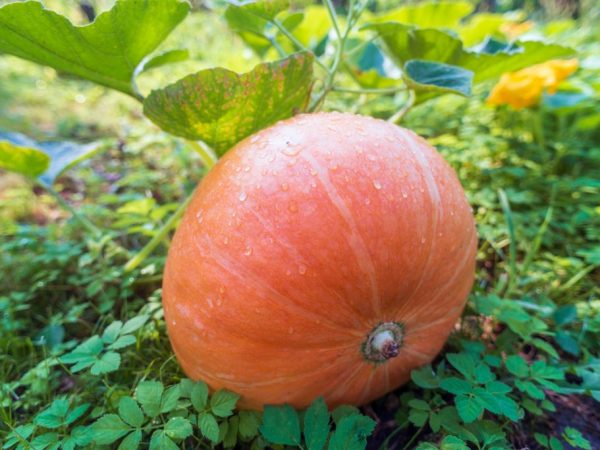Features of feed pumpkin
There are many legends about this vegetable. The first mention of the pumpkin is found in the Bible. It is ubiquitous these days. Both table and fodder pumpkin are unpretentious in cultivation, they give a consistently high yield. Both varieties have beneficial properties. The latter is often used as livestock feed, which is reflected in its name.

Features of feed pumpkin
Livestock feeding
Due to the high carbohydrate content, pumpkin is used by livestock breeders as a winter feed for cows, pigs and sheep. To do this, it is simply cut in half and fed to animals. Livestock happily eat chopped vegetables and frozen. In a heavily chopped form, it is introduced into the winter menu for chickens.
For 2 months, the pumpkin is stored fresh in a dry dark room at a temperature not exceeding 5 ° C. In order to increase the period of its use, silage fodder is made from it together with leaves, grass of legumes, waste from grain production. After that, with fodder beets, it is laid in silo pits.
Pumpkin efficiency
After the introduction of fodder pumpkin into the diet of farm animals, the following changes are observed:
- dairy products have a pleasant smell, color and contain more carotene than milk from cattle raised on other feed;
- animals have healthy offspring without complications during childbirth;
- the rate of increase in the pig's weight increases significantly;
- the cow has an increase in the amount of milk;
- chickens lay more often, and the yolk of eggs is rich in color.
The introduction of this vegetable into the diet of animals, due to the peculiarity of its chemical composition, improves the assimilation of rough concentrated feed by them. As a result, fattening is more efficient, which reduces costs for the farmer.
The best varieties
Scientists call this culture a false berry. But these "berries" are one of the largest on earth. The fodder crop has a high yield. Its features are its large size, thick rind and friable texture of the flesh.
Sowing seeds per hectare gives up to 50 tons of fruits. This relatively cold hardy plant has the longest shelf life of any other vegetable.
Of the large number of species, it is worth highlighting the Stopound variety. This pumpkin was named so because by its mass it reaches 25 kg, and sometimes it weighs even more. The shape of the fruit is spherical. The pulp is orange, loose in structure. Pumpkin is resistant to transportation and storage.
The variety Volzhskaya gray 92 is widely known. Its resistance to drought and diseases is noted. It is most widespread in the Volga region due to the presence of sandy soils. Like the previous variety, it stands out for its high yield and high weight.
In agriculture, varieties such as Hybrid 72, Record, Titan, Gribovskaya bush 189, etc. are widespread.
Suitability for food

Some varieties of fodder pumpkins are eaten
Special cultivated varieties are most widespread in cooking.Fodder pumpkin, due to its peculiar taste, is not so popular among people. However, some of its varieties, for example Volzhskaya gray 92, are acceptable for human consumption.
For many years this vegetable was eaten only by peasants. Citizens and citizens who considered themselves well-to-do did not eat it.
On the American continent, this product was eaten by people who were considered the most backward - the Indians. However, as a result of the onset of food problems, they began to treat her differently.
And today, pumpkin is one of the most beloved American dishes. No Thanksgiving is complete without her. Whole fields are planted with this vegetable for Halloween use only.
The flesh is not the only edible part of the fruit. Almost all parts of a vegetable have nutritional value: flowers, leaves, seeds, stems. All parts of the plant contain vitamins A, C, as well as iron and calcium. They are boiled, fried, baked. Flowers can be eaten even raw.
Seeds are especially preferred. They are eaten raw, dried and fried. The pulp contains many nutrients, setting records for many vegetables. Carotene, which is responsible for clarity of vision, is 5 times more in pumpkin than in carrots.
By adding vitamin E (oil, dried apricots, seeds) to it, we get a delicious cure for cancer that will improve the quality of the skin, balance hormones and reduce the symptoms of menopause. Due to its low calorie content, obese people include it in their diet.
The vegetable has many advantages, but there are also disadvantages. This variety is contraindicated for those who have an active stage of diseases of the gastrointestinal tract, pancreas, and liver.
If you have an upset stomach, do not eat this vegetable either. People with severe diabetes are not allowed to consume raw pumpkin.
Differences between fodder pumpkin and dining gourd
The main difference between a fodder vegetable and a table vegetable is its large size. The latter is of a more modest size. For a product for human consumption, very different requirements apply, such as ease of use.
Table crops can grow very small and can be used in whole cooking. Two equally important requirements for pumpkin used for human consumption are higher taste and valuable nutritional composition.
Price
This variety costs about the same in different regions. The price of a fodder pumpkin ranges from 15-20 rubles. for 1 kg. The cultivation of this giant vegetable is considered today one of the promising directions in agriculture.
The sale of seeds is especially profitable, because they are the most expensive part of the vegetable.

